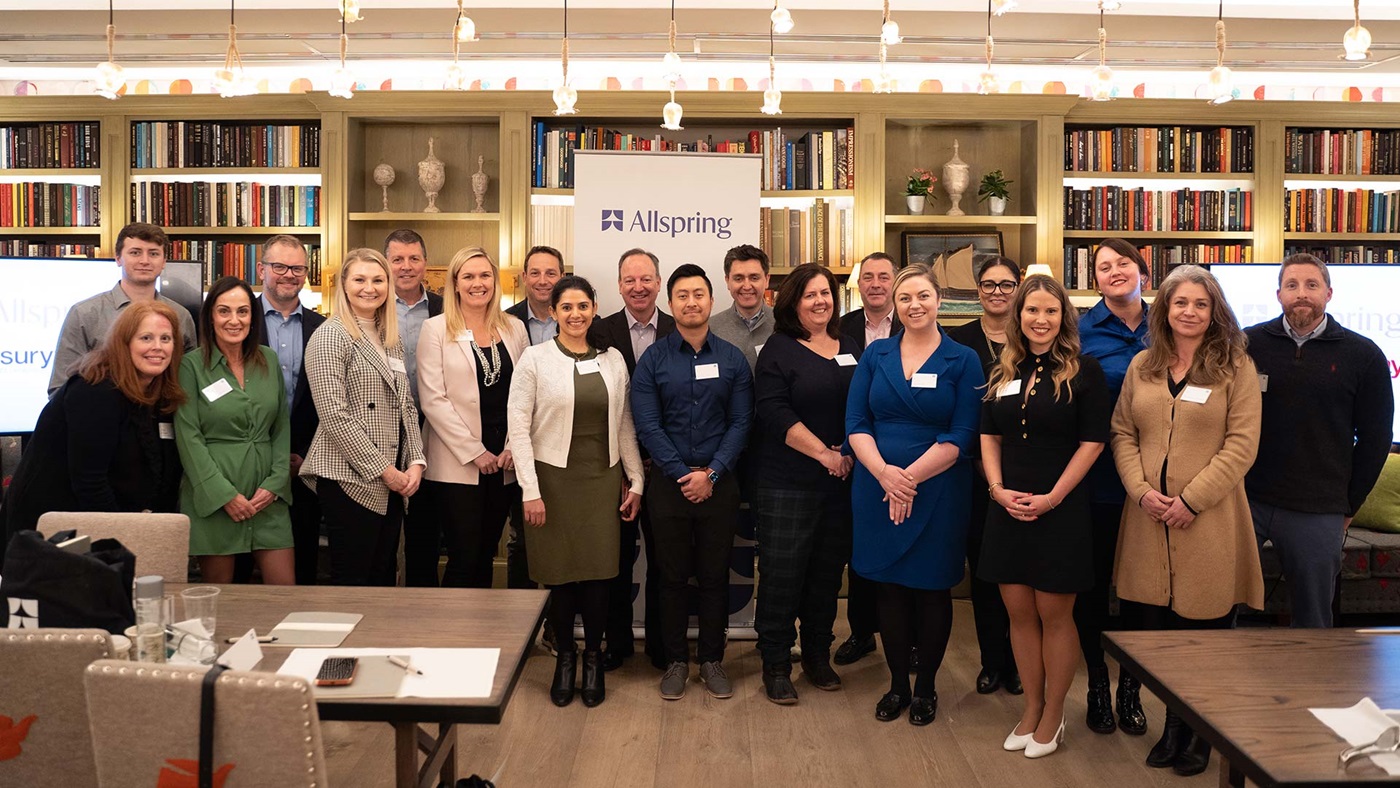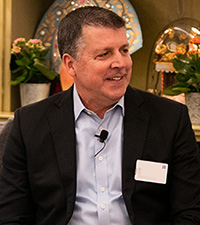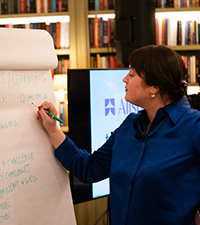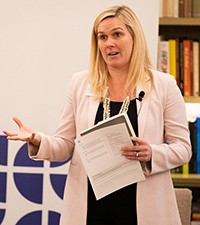

When Treasury Today Group and Allspring Global Investments hosted their second workshop for our Future Treasurer series in New York, the importance of networking and the treasury community were front and centre of discussions.
Watch video
“Networking, making new relationships and bringing new and established talent together is the point of this gathering,” said Sophie Jackson, Publisher & Head of Strategic Content at Treasury Today Group, opening the second Future Treasurer gathering in New York. Hosted by Allspring Global Investments and Treasury Today Group, Sophie explained that the intimate workshop, last held on West coast, seeks to foster networking and community in treasury by sharing experiences and learnings to nurture peer-to-peer interaction. “People are good at fostering relationships in their own company but need support to network outside this.”

For Robert White, Head of Liquidity, Global Client Strategy Group at Allspring Global Investments, treasury’s community is the ground on which the profession is built. He shared the different ways he relies on his treasury network, detailing the importance of client relationships and the satisfaction that comes from achieving goals as part of a team. “It’s a relationship business,” he said.
Robert explained that he uses his network to recruit talent into his team. “I leverage my network to find the best-in-class talent,” he said, explaining that he also uses it to support colleagues embarking on the next step of their career if he doesn’t have an opening for them on his own team. “I don’t want to hold people back and if I can leverage my network to help people find new positions I will,” he said.
In another example of the value it sees in community, Allspring Global Investments is building its network of rising talent via Allspring U, a two-and-half day educational forum that provides a real-world introduction to treasury spanning investment management, structuring portfolios, and credit and risk management. Robert explained that the sessions encourage shared learning through common experiences that face a treasury organization.
Community characteristics
A key characteristic of treasury celebrated in our Future Treasurer series is the fact people arrive in the profession by different routes – and everyone is willing to share their journey. Like fellow panellist Bhavna Kumarapuram, Director, Corporate Treasury, The New York Times, who explained how she began her career in the treasury department of a sugar manufacturing company in India. A first role that instilled the “fundamentals” of treasury management and her enduring passion for cash management. “I love treasury because of conversations around cash,” she told attendees. Describing treasury’s “privileged position” as a custodian of cash, entrusted with access and visibility in a top-down view that “shouldn’t be taken for granted.”
profession by different routes – and everyone is willing to share their journey. Like fellow panellist Bhavna Kumarapuram, Director, Corporate Treasury, The New York Times, who explained how she began her career in the treasury department of a sugar manufacturing company in India. A first role that instilled the “fundamentals” of treasury management and her enduring passion for cash management. “I love treasury because of conversations around cash,” she told attendees. Describing treasury’s “privileged position” as a custodian of cash, entrusted with access and visibility in a top-down view that “shouldn’t be taken for granted.”
Her next role landed her in a mature treasury department for a US grocery supply chain group. Here she built on her treasury foundation and gained new certifications. Memorable experiences from this period include working on projects around treasury management system implementations; she built on her cash management expertise and was involved in a private placement.
Later she moved to a start-up in the healthcare education space. Reporting directly to the CFO, she learnt that treasury is no longer a static role but offers real proximity to corporate leadership. Here her tasks included overseeing bank relationships and developing the company’s reconciliation processes and risk mitigation strategies. “I was recognised and appreciated,” she says, recalling a validating time in her career when everything she’d learnt came to fruition. “The business was growing rapidly. I spent a lot of my time developing corporate accounting processes, leading system integrations, and solving problems with technology.”
Crisis management
In her current role she’s earned her stripes in crisis management during a period that has reiterated the importance of her network and the treasury community all over again. When western governments introduced sweeping sanctions in response to Russia’s invasion of Ukraine, the company’s ability to pay staff and partners in Russia was thrown into turmoil. It pushed her relationships with banks to the fore, she said. “One of the most important things is to stay informed,” she explained. “Things were changing so rapidly, and we relied on our banking partners to tell us what was changing.”

Her team also ensured other parts of the business were also informed. “We helped disseminate information across the company. It was about staying engaged with all stakeholders and being aware of the risk.” She recalled how the scale of the challenge increased when banks shut down payment partners and traditional payment avenues, forcing new solutions and creativity, including opening new bank accounts and paying via crypto.
Above all, those hairy days underscored the importance of community, sharing experiences and peer-to-peer collaboration. Calls with other corporate treasury teams battling the same issues around payroll and shuttered bank accounts provided essential comfort and advice and she urged delegates to always share their pain points.
Inclusion
The workshop reflected on the different ways treasury is involved in nurturing inclusivity. The New York Times Company runs Employee Resource Groups which organise events where people within the company can network and gather. It provides a space for minority groups to feel refreshed and recognise that there are people within the company who are similar to them, said Bhavna. “I met colleagues and guest speakers at these events who are from the same place as I am from and look like me,” she said. “It makes people feel included.”
She explained how she prioritises teamwork for new hires as a way to draw them in and ensure they feel part of the company. “Doing things in teams makes people feel included,” she said. Recounting her own experience, she recalled how being acknowledged publicly as a team leader by her boss helped her feel included in a male environment. “I would instantly feel insecure because there were no other women in the room – it happened a lot,” she said. “My boss said, ‘Bhavna is in charge; she will make the decision so please be in touch with her.’ It helped me eliminate the misconceptions I had about myself, and everyone looked at me and realised I was in the room. To call out a person in charge or include someone who is new and not quite there yet shows belief in their skills and supports them. Inclusivity starts within your team and it’s the quietest people who need to be heard.”
Mentoring
Delegates discussed the role of mentoring and reverse mentoring to foster treasury community and support career progression. Mentorship allows people to build relationships outside their immediate colleagues and gives a window into other lived experiences and different generations. Robert recalled how he still speaks to his “very first boss” who introduced him to treasury. Attendees also heard how buddy systems give treasury access to expert colleagues in, say, FX or investment management, facilitating peoples’ ability to reach out to experts in the field and sit down with peers in different departments in a setting that allows candid questions and discussions. Fostering cross department relationships also helps ensure people don’t leave a company, giving introductions to different divisions within a company.
support career progression. Mentorship allows people to build relationships outside their immediate colleagues and gives a window into other lived experiences and different generations. Robert recalled how he still speaks to his “very first boss” who introduced him to treasury. Attendees also heard how buddy systems give treasury access to expert colleagues in, say, FX or investment management, facilitating peoples’ ability to reach out to experts in the field and sit down with peers in different departments in a setting that allows candid questions and discussions. Fostering cross department relationships also helps ensure people don’t leave a company, giving introductions to different divisions within a company.
Mentoring and reverse mentoring involves each person holding the other accountable. It also requires commitment and putting time in the calendar. Delegates acknowledged that for younger people, approaching a senior colleague and asking for their time can be challenging.
Unofficial mentoring, whereby experienced colleagues willingly bounce ideas and juniors can listen in and emulate their skills, is just as valuable. Watching and listening offers insight on how to answer questions or handle a difficult situation.
Treasury today
The conversation turned to the key issues shaping treasury today. Attendees cited the challenge of onboarding and regulatory issues and achieving a work life balance. Reflecting that video meetings shouldn’t be “front of centre” over in-person meetings, and that achieving a work-life balance meant understanding when the workday was over.

Lastly, the conversation turned to the value of building networks outside the workplace. For example, volunteering as a treasurer for charities is a way to access new communities and unite with people from different walks of life. Delegates concluded with a nod to their culture of thinking what treasury has to offer others – rather than just what treasury has to gain.
“It takes effort to network but once you are here, it is fulfilling and there is a connection. We are committed to providing more opportunities like this,” said Kelly Vives, Chief Marketing and Communications Officer, Allspring Global Investments. The workshop closed with Sophie encouraging attendees to imagine their future professional self – and begin, one step at a time, on that journey.